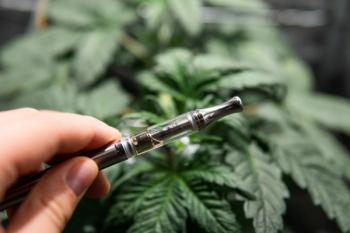
Cannabis Science and Technology
- June/July 2018
- Volume 1
- Issue 2
A Comprehensive Approach to Pesticide Residue Analysis in Cannabis
As the number of U.S. states allowing the adult use of cannabis and cannabis products increases, so does the need for product testing before retail sale. States that have legalized recreational use have specified testing requirements for pesticide residues in cannabis flower and cannabis products. Because the specific pesticides and action levels vary from state to state, a comprehensive approach to residue analysis can meet the requirements of multiple U.S. state regulations with a single analysis. The challenge of quantifying pesticide residues in cannabis is complex because of the high concentration of cannabinoids and terpenes relative to the levels of pesticides that may be present. Here we present a straightforward acetonitrile extraction using a solid-phase extraction (SPE) cartridge and targeted dispersive solid-phase extraction (dSPE) cleanup. The final dilute extract is analyzed with both gas chromatography–tandem mass spectrometry (GC–MS/MS) and liquid chromatography–tandem mass spectrometry (LC–MS/MS) for a comprehensive target list (200+ compounds) that encompasses those identified on individual U.S. state lists. Limits of quantitation meet or exceed individual U.S. state requirements.
For U.S. states that have legalized the recreational or medicinal use of cannabis and cannabis products, there are presale testing requirements meant to address quality and consumer safety (1–3). In the absence of guidance at the federal level, states must establish the scope of the required testing in addition to any minimum or maximum values before product release into the marketplace. These compliance efforts, combined with the lack of true consensus methods, allow individual laboratories to develop analytical methodology that typically only meet the regulatory requirements of the single state where the laboratory is located.
Conventional agricultural commodities are subject to U.S. maximum residue levels (MRLs) for pesticides labeled for use on each specific commodity. These MRLs are established by the U.S. Environmental Protection Agency (EPA) as part of the pesticide registration process. Commodities destined for international export will be subject to the MRLs established by the importing country. With a wide range of commodities, pesticides, and MRLs, a comprehensive approach to residue testing is necessary to ensure the commodity complies with all applicable regulations. This comprehensive approach to pesticide residue analysis can be applied to cannabis and cannabinoid products. U.S. states with approved cannabis sales have developed target lists for pesticides with associated “action levels.” An action level is not an MRL, but rather a subjective number assigned by state regulators to establish criteria for laboratory testing. These action levels were determined by a combination of factors such as laboratory capabilities, analytical techniques, and evaluating MRLs from other commodities (4,5). Additionally, U.S. states have language in statutes or administrative rules that prohibit any pesticide from being applied off-label (that is, not following product label instructions) to any crops. Pesticide products not included on a state list could potentially be applied during cannabis cultivation. Because U.S. state regulations require a limited scope targeted testing procedure, these residues would not be discovered during presale screening and would find their way into the final consumer products on retail shelves.
QuEChERS (quick, easy, cheap, effective, rugged, and safe) is a common approach for the extraction of pesticide residues (6,7), and has been applied to both cannabis and cannabis products. Although it generates acceptable results for most pesticides in cannabis, it was developed for samples that contain greater than 70% moisture. Cannabis flower typically contains 10–15% moisture so the addition of water to each sample is necessary to generate the desired partitioning that is the principle of the QuEChERS technique. Moreover, the addition of water and salts in the QuEChERS approach generates an exothermic reaction and an increase in pH-both of which can degrade sensitive pesticides. An alternate approach is a serial extraction using acetonitrile and a solid-phase cleanup step (8). This procedure results in less coextracted material and improved recoveries for the more polar pesticides.
The general trend among testing laboratories is to develop analytical methods using a single extraction followed by analysis using tandem quadrupole mass spectrometers. With the limited scope of many U.S. state regulatory lists, liquid chromatography–tandem mass spectrometry (LC–MS/MS) is often the choice when a single instrument is used. For a true comprehensive residue analysis, a dual-platform MS/MS scheme should be developed using both gas chromatography–tandem mass spectrometry (GC–MS/MS) and LC–MS/MS. This approach allows laboratories to evaluate compounds on each platform to optimize sensitivity and chromatographic performance. Many compounds can be identified and quantified using both techniques, giving laboratories orthogonal confirmation for difficult sample matrices.
The challenge with pesticide residue analysis in cannabis is the concentration difference between the pesticide residues and those of the coextracted cannabinoids and terpenes. These coextracted materials complicate residue testing by introducing matrix effects in the MS/MS system, and lead to increased system maintenance and instrument downtime. To address these issues, both MS/MS platforms need to have sufficient sensitivity to allow for large dilution factors that will reduce matrix effects and maintenance while meeting state-specific action levels.
Sample Preparation
In our laboratory, sample preparation includes a serial extraction with acetonitrile followed by a solid-phase cleanup. A 1.0-g aliquot of homogenized sample was accurately weighed into a 50-mL centrifuge tube, with 15 mL of acetonitrile added to each tube along with a ceramic homogenizer. The tubes were sealed and mechanically shaken for 2 min at 1500 strokes/min. The acetonitrile was decanted through a conditioned Strata-X (Phenomenex) 33-µm solid-phase extraction (SPE) cartridge (500 mg/12 mL), and the eluent was collected in a second 50-mL centrifuge tube. The primary extraction tubes were rinsed with two additional 5-mL portions of acetonitrile, and decanted through the SPE cartridge. All eluent fractions were combined in the second 50-mL centrifuge tube. The solvent extract was brought to a final volume of 25 mL with acetonitrile. After this step we have a dilution factor of 25x from the initial sample amount.
Analytical Instrumentation
As previously discussed, the analyses are conducted with both LC–MS/MS and GC–MS/MS systems. The GC–MS/MS system was an Agilent 7890B GC equipped with an Agilent 7010 MS/MS system with a high efficiency source (HES). The GC system was configured with a multimode inlet (MMI) and a Purged Ultimate Union (PUU) to allow for column backflushing. The MMI is capable of fast temperature ramping, allowing for a “cool” inlet injection. The initial inlet temperature was 180 °C. The temperature was ramped to 280 °C at 400 °C/min post-injection. Combining the “cool” inlet condition with a pulsed splitless injection helped reduce degradation of thermally labile compounds in the GC inlet. To improve peak shape for more-polar analytes, the PUU was placed at the midpoint of two analytical columns of different stationary phases (column 1 = HP-35MS, 15 m x 0.25 mm, 0.25-µm df; column 2 = HP-5, 15 m x 0.25 mm, 0.25-µm df). The backflush timing was configured to begin mid-run as determined by the retention time of the last compound exiting the PUU, and continued post-run to flush nonvolatile compounds from the injection port.
The LC–MS/MS system was an Agilent 1260 Infinity II with a Multisampler connected to an Agilent 6470 MS/MS system. A Poroshell 120 Phenyl-Hexyl column (100 mm x 2.1 mm, 2.7-µm dp) was selected because of its chromatographic performance and robustness. The LC column provided excellent chromatography at standard (non-ultrahigh-pressure liquid chromatography [UHPLC]) pump pressures, again reducing instrument downtime. A feature of the Multisampler is the ability to perform an injection pretreatment before sample injection. A 2-µL sample was sandwiched between two 10-µL aliquots of water, and injected onto the analytical column. This sample injection sandwich is not a dilution, it simply creates a polar environment for the sample injection, which improves peak shape for the early eluted compounds. Mobile-phase A was 5 mM ammonium formate with 0.1% formic acid in water–methanol (95:5) and mobile-phase B was 5 mM ammonium formate with 0.1% formic acid in methanol–water (95:5).
Calibration
Both MS/MS systems share the same calibration technique. Calibration curves may use a linear fit (minimum five points) or a quadratic fit (minimum six points), with minimum correlation coefficients of 0.990 for all 215 compounds. The low calibrator concentration was 0.2 ng/mL for most compounds (92%), which corresponds to a sample concentration of 0.1 mg/kg after cleanup or final dilution factors. The upper range of the calibration curve was 10 ng/mL or 20 ng/mL depending on the individual analyte. All calibration curves used a 1/X weighting factor and exclude the origin. No internal standards were used, and all quantitative results were calculated using the external standard technique.
Analysis
GC–MS/MS extracts were prepared for analysis using a combination of dSPE cleanup and dilution. For the dSPE cleanup, 100 µL of sample extract was added to a 2-mL disposable tube containing 50 mg of primary secondary amine (PSA), 50 mg of C18, 7.5 mg of graphitized carbon, 150 mg of magnesium sulfate, and 900 µL of 1:1 hexane–acetone. These tubes were capped, vortexed for 30 s, and centrifuged for 2 min. A 300 µL aliquot was removed from the tube and added to an autosampler vial containing 300 µL of hexane–acetone (1:1). At this point, the sample extract consists of 5% acetonitrile–95% hexane–acetone (1:1). This solvent system gives much better performance with GC compared to 100% acetonitrile. The combined dilutions from the cleanup step (10x) and post cleanup (2x), with the initial extraction (25x) result in an overall dilution factor of 500x. Using this approach, background noise and matrix in the final extract was significantly reduced (Figure 1) and recoveries for the target pesticides were within acceptance limits of 70–120%. (See upper right for Figure 1, click to enlage; Figure 1: Full-scan chromatograms: Full-scan data were collected for both GC–MS/MS [top] and LC–MS/MS [bottom]. The black chromatogram is the initial sample extract [post SPE column], the blue represents a 20x dilution of initial extract. The red chromatogram is post dSPE cleanup [50 mg PSA/50 mg C18/7.5 mg GCB/150 mg MgSO4].)
The LC–MS/MS extracts were prepared for analysis using only a final dilution step. This final dilution of 50 µL of extract into 950 µL of acetonitrile results in a factor of 20x. Combined with the initial extraction, this dilution leads to an overall dilution factor of 500x. Again, the background matrix is reduced (Figure 1) and the recoveries for target pesticides are within acceptance limits of 70–120%.
Each cannabis strain will have its own unique profile of cannabinoids and terpenes, which may present different background interferences affecting pesticide determinations. If dilution alone does not adequately address matrix effects or interferences, there is an optional dSPE cleanup that can be applied to extracts for LC–MS/MS analysis. This optional step uses PSA as a sorbent. PSA is a powerful cleanup sorbent for challenging samples, but may result in low recoveries for some compounds. Recoveries for spinotoram, spinosad, spirotetramat, and spiroxamine can be reduced to <50% when subjected to a dispersive technique containing PSA, and daminozide is unrecoverable.
A concept developed by Schenck and Wong (9) to address the loss of planar pesticides when using graphitized carbon as a cleanup sorbent can be applied to compounds strongly retained by PSA. To improve recoveries of planar pesticides when using graphitized carbon, toluene (25–30%) is added to sample extract to push planar pesticides off the sorbent. When using a dSPE designed for fatty samples (50 mg of PSA, 50 mg of C18, 150 mg of magnesium sulfate), a similar approach can be used with methanol. Adding methanol at the dSPE step will improve the recoveries for compounds retained by PSA. The data indicate that 10–20% methanol addition will increase recoveries for the problematic compounds (Figure 2). (See upper right for Figure 2, click to enlage; Figure 2: To increase the recovery for compounds retained by PSA using a dSPE cleanup methanol can be added to sample extract in the cleanup tube. The chart shows the percent recovery as a function of methanol added.) This approach will improve recoveries to acceptable levels with minimal matrix returning to the extract. Keep in mind that no amount of methanol will recover daminozide from PSA, and typical reversed-phase chromatography is not optimal for measuring daminozide residues. A more appropriate technique would be an extraction optimized for polar compounds and using hydrophilic-interaction chromatography (HILIC) chromatographic techniques (10).
Results and Discussion
A solvent extraction with a pass through solid-phase cleanup gives an extract with less coextracted materials when compared to extracts from a QuEChERS technique. Having a single extraction procedure that can be split to both MS/MS platforms streamlines the workflow, resulting in higher sample throughput. Dispersive cleanup and dilution techniques can be optimized for each analytical technique and compound list to give the necessary precision and accuracy. The cleanup and dilution procedure for GC–MS/MS analysis allows the laboratory to place the sample extract into a solvent that is more amenable to GC (hexane–acetone). An optional dispersive cleanup procedure for LC–MS/MS analysis can be used if adverse matrix effects or interferences are encountered.
This procedure was validated for 215 pesticides (Table I) split between the two MS/MS platforms. (See upper right for Table I, click to enlage; Table I: Comprehensive pesticide target list: GC–MS/MS [bold] LC–MS/MS [italic].) A set of five replicates was prepared at the limit of quantitation (LOQ) for each compound. The signal-to-noise ratio (S/N) criterion of 10:1 (quantitation ion) was met for each compound at the LOQ. For the GC–MS/MS-amenable compounds, 72 of the 74 pesticides had recoveries of 70–120%, and the percent relative standard deviation (%RSD) was less than 15% for all 74 compounds. For compounds analyzed by LC–MS/MS, all 141 pesticides had recoveries of 70–120%, and the %RSD was below 15% for 138 of 141. The LOQ was validated at 0.1 mg/kg for all compounds except those listed in Table II. (See upper right for Table II, click to enlage; Table II: Compounds with LOQs above 0.1 mg/kg.)
Conclusion
The key to successful pesticide residue analysis in cannabis and cannabinoid products is understanding and gaining control of the background matrix. With a reduced matrix load in the final extract, GC issues like fouled or plugged syringes, dirty inlets or liners, and contaminated sources are greatly reduced. LC issues such as fouled or dirty valves, decreased column performance, contaminated spray shields and sources are less likely with the reduced matrix present in the sample extracts. With fewer potential interfering isobars, detector conditions are more stable and performance increases, resulting in increased sensitivity and stability in both baselines and compound response. All these factors combined provide a laboratory with increased sample throughput and a reduction in downtime because of maintenance and repairs. The use of high sensitivity MS/MS systems will allow laboratories to utilize calibration curves at sub-parts-per-billion levels.
By using a comprehensive approach to residues analysis, as is traditionally applied to conventional agricultural crops, a laboratory will be able to screen for the compounds required by regulation in addition to pesticides not included on a U.S. state list. There are many pesticides with similar chemistries and modes of action as those on a state specific list that could go undetected and enter the retail marketplace unless a more comprehensive approach is taken.
Acknowledgment
The authors would like to thank Melissa Churley with Agilent Technologies and Dr. Joan Stevens for their assistance with this work.
References:
- Oregon Administrative Rules 333-007-0400.
- California Code of Regulations, Title 16, Division 42. Bureau of Cannabis Control, Chapter 11, § 5719.
- Washington Administrative Code 246-70-050.
- D.G. Farrer, “Technical report: Oregon Health Authority’s Process to Decide Which Types of Contaminants to Test for in Cannabis” (Oregon Health Authority, 2015).
- J. Konschnik, H. Krug, and S. Kassner, Cannabis Science and Technology1(1), 42–47 (2018).
- AOAC Official Method 2007.01, Pesticide Residues in Foods by Acetonitrile Extraction and Partitioning with Magnesium Sulfate, Gas Chromatography/Mass Spectrometry and Liquid Chromatography/Tandem Mass Spectrometry, First Action 2007.
- CSN EN 15662, Foods of Plant Origin - Determination of Pesticide Residues Using GC-MS and/or LC-MS/MS Following Acetonitrile Extraction/Partitioning and Clean-Up by Dispersive SPE - QuEChERS-Method.
- M.J. Hengel, J. Am. Soc. Brew. Chem.69(3),121–126 (2011).
- F.J. Schenck and J.W. Wong in Analysis of Pesticides in Food and Environmental Samples, J.L. Tadeo, Ed. (CRC Press Inc., Boca Raton, Florida, 2008), Chapter 6.
- M. Anastassiades, D.I. Kolberg, E. Eichhorn, A. Benkenstein, S. Lukacevic, D. Mack, C. Wildgrube, I. Sigalov, D. Dörk, and A. Barth, “Quick Method for the Analysis of Numerous Highly Polar Pesticides in Foods of Plant Origin via LC-MS/MS involving Simultaneous Extraction with Methanol (QuPPe-Method),” Version 8.1, EURL-SRM, March 2015.
Rick Jordan is the Laboratory Manager at Pacific Agricultural Laboratory in Sherwood, Oregon. Daniel Miller is the Technical Director at Pacific Agricultural Laboratory. Lilly Asanuma is a chemist at Pacific Agricultural Laboratory. Anthony Macherone is a Senior Scientist with Agilent Technologies and a visiting professor at The Johns Hopkins University School of Medicine. Direct correspondence to:
How to Cite This Article
R. Jordan, L. Asanuma, D. Miller, and A. Macherone, Cannabis Science and Technology1(2), 26-31 (2018).
Articles in this issue
over 7 years ago
Preview of the 2018 Cannabis Science Conferenceover 7 years ago
Cannabis Quality Control Testing Using Gas ChromatographyNewsletter
Unlock the latest breakthroughs in cannabis science—subscribe now to get expert insights, research, and industry updates delivered to your inbox.



